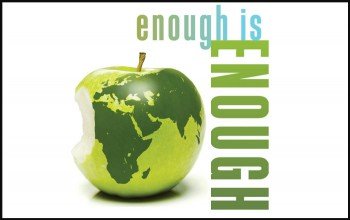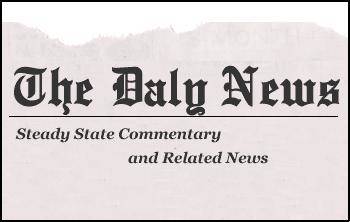The latest Transition Network Newsletter addresses the question - and looks at a report just come out:
New report: Climate After Growth
"The nearly ubiquitous belief of our elected officials is that addressing the climate crisis must come second to ensuring economic growth. This is wrongheaded—both because it underestimates the severity of the climate crisis, and because it presupposes that the old economic "normal" of robust growth can be revived. It can’t.
In fact, we have entered an era of “new normals”—not only in our economy, but in our energy and climate systems, as well. The implications are profound:
- The New Energy Normal. The era of cheap and easy fossil fuels is over, leading the industry to resort to extreme fossil fuel resources (tar sands, mountaintop removal coal mining, shale gas, tight oil, and deepwater oil) to meet demand. Unfortunately, these resources come with enormous environmental and economic costs, and in most instances provide far less net energy to the rest of society. They also require much higher prices to make production worthwhile, creating a drag effect on the economy. As a result, high energy prices and economic contraction are likely to continue a back-and-forth dance in the coming years.
- The New Climate Normal. Climate stability is now a thing of the past. As extreme weather events grow in severity, communities are increasingly adopting strategies that build resilience against the effect of these and other climate shocks. At the same time, we must take dramatic steps if we hope to avoid raising global temperatures more than 2°C above pre-industrial levels. According to Kevin Anderson of the Tyndall Centre, this would require a 10% reduction in CO2 emissions per year, starting now—a rate so significant that it can only be achieved through dramatic reductions in energy use.
- The New Economic Normal. We’ve reached the end of economic growth as we’ve known it in the US. Despite unprecedented interventions on the part of central banks and governments, the so-called economic recovery in the US and Europe has been anemic and has failed to benefit the majority of citizens. The debate between stimulus and austerity is a distraction, as neither can fully address the factors that spell the end of economic growth—the end of the age of cheap oil, the vast mountains of debt that we have incurred, the diminishing economic impacts of new technologies, and the snowballing costs of climate change impacts.
These fundamental changes in our energy, climate, and economic systems require unprecedented (and previously politically untenable) strategies. Yet this new reality is still largely unrecognized. As long as our leaders’ predominant focus remains on getting back to the days of robust economic growth, no national or international climate policies will be enacted to do what is required: cut fossil fuel use dramatically.
Instead of focusing on achieving climate policy within the economic growth paradigm, the US environmental community must embrace strategies that are appropriate to these “new normals.”
Responding to each of these new energy, climate, and economic “normals” will require one common strategy: building community resilience. Efforts that build community resilience enhance our ability to navigate the energy, climate, and economic crises of the 21st century. Done right, they can also serve as the foundation of a whole new economy—an economy comprised of people and communities that thrive within the real limits of our beautiful but finite planet.
Thankfully, innovations that build community resilience are cropping up everywhere, and in many forms: community-owned, distributed, renewable energy production; sustainable local food systems; new cooperative business models; sharing economies, re-skilling, and more. While relatively small and inherently local, these projects are spreading rapidly and creating tangible impacts.
Growing the community resilience movement to the national and global scale that’s needed will require the full support and participation of the US environmental community. Specifically we need to:
- build the capacity of groups—large and small—who are leading these efforts;
- support the growth of a global learning network; and
- enable local investments to flow into community resilience enterprises.
By making community resilience a top priority, environmentalists can offer an alternative to the “growth at all costs” story, one in which taking control of our basic needs locally has multiple benefits. Community resilience-building can create new enterprises and meaningful work, and increase well-being even as GDP inevitably falters. It can reduce greenhouse gas emissions and dependence on fossil fuels, while addressing social and economic inequities. And it can strengthen the social cohesion necessary to withstand periods of crisis.
On their own, community resilience projects can’t overcome all the environmental, energy, economic, and social equity challenges facing us. That will require coordinated global, national, regional, community, business, neighborhood, household and individual efforts. But the community resilience movement can help create the conditions in which what is now “politically impossible becomes politically inevitable.”
How the environmental community responds to the risks and opportunities of the new energy, climate, and economic “normals” will make an enormous difference in its success, and in the fate of humankind.
New report: Climate After Growth | Transition Network
 Rob Hopkins, founder of the Transition Network. (Photo: Transition Network / Flickr)A new policy paper from the Post Carbon Institute, a nonprofit think tank, argues the environmental movement must embrace what the authors have deemed a "new normal" of declining economic growth while building solidarity with the so-called new economy movement, emphasizing community-based, sustainable solutions in an era of globalization.
Rob Hopkins, founder of the Transition Network. (Photo: Transition Network / Flickr)A new policy paper from the Post Carbon Institute, a nonprofit think tank, argues the environmental movement must embrace what the authors have deemed a "new normal" of declining economic growth while building solidarity with the so-called new economy movement, emphasizing community-based, sustainable solutions in an era of globalization.
The paper, "Climate After Growth," was cowritten by Post Carbon Institute’s executive director, Asher Miller and Rob Hopkins, founder of the Transition Network, which supports community-led responses to climate change and helps to build strong, sustainable local economies.
The paper hopes to put to rest the false dichotomy between the imperative of economic growth over environmental protection once and for all by making the case that the over-arching paradigm of economic growth is coming to an end in any case, regardless of the ongoing climate crisis.
This notion has been around for some time, but as a 'steady-state' economy:
Herman Edward Daly (born 1938) is an American ecological economist and professor at the School of Public Policy of University of Maryland, College Park in the United States. Daly was Senior Economist in the Environment Department of the World Bank, where he helped to develop policy guidelines related to sustainable development. While there, he was engaged in environmental operations work in Latin America. He is closely associated with theories of a Steady state economy. Before joining the World Bank, Daly was a Research Associate at Yale University,[1] and Alumni Professor of Economics at Louisiana State University. He was a co-founder and associate editor of the journal, Ecological Economics.
Daly is a recipient of an Honorary Right Livelihood Award,[2] the Heineken Prize for Environmental Science from the Royal Netherlands Academy of Arts and Sciences, the 1992 University of Louisville Grawemeyer Award for Ideas Improving World Order,[3] the Sophie Prize (Norway), the Leontief Prize from the Global Development and Environment Institute and was chosen as Man of the Year 2008 by Adbusters magazine. He is widely credited with having originated the idea of uneconomic growth, though some credit this to Marilyn Waring who developed it more completely in her study of the UN System of National Accounts.[4]
In 1989 Daly and John B. Cobb developed the Index of Sustainable Economic Welfare (ISEW), which they proposed as a more valid measure of socio-economic progress than gross domestic product.
Perpetual economic growth is neither
possible nor desirable.
Growth, especially in wealthy nations,
is already causing more problems
than it solves.
Recession isn't sustainable or healthy either.
The positive, sustainable alternative is
a steady state economy.
The Club of Rome's 1972 Report is still generating debate:
Limits to Growth
Exploring the physical limits to economic growth
Limits to Growth
Exploring the physical limits to economic growth
Beyond green growth: why we need a world
without economic growth
Beyond
concepts of green growth or sustainable growth there is also that of 'no
growth'. From OurWorld 2.0, part of the Guardian Environment Network
March 2009, Tim Jackson put forward the
idea of prosperity without growth in a report published by the United Kingdom's Sustainable Development Commission and followed up with a book of the same name
released last November. The book is a best seller (ranked 1,729 on
Amazon) and in it he argues convincingly that we can still prosper without
adhering to the encoded mantra of expansion and growth that permeates modern
market economies.
More recently, in January 2010, Andrew
Simms and Victoria Johnson at the new economics foundation (nef) published a
more emphatic message in their report entitled Growth isn't possible. They argue that we should abandon the notion of
growth altogether. The premise is that we need a new economic model "that
allows the human population as a whole to thrive without having to rely on
ultimately impossible endless increases in consumption".
Japan is an example in point:
Resilience and the Steady-State Economy: Japan's Sustainability Lessons from the 2011 Disasters and a Declining Population
And when it comes to having a steady-state economy, Japan has another advantage -- our experience with the Edo Period. The Edo Period lasted for 265 years, from 1603 to 1867. During that time, the country was closed to the world and experienced no foreign invasions. The country made a tremendous effort to sustain by itself without depending on anything from overseas. It was also quite a peaceful time, with almost no domestic conflicts. In this backdrop, Japan developed its own unique economy and culture.
The country's total population was stable at some 30 million for two and a half centuries, without large fluctuations. Because of its closed-door policy, Japan did not import anything from other countries, but relied on domestic energy and resources. Eisuke Ishikawa, a leading researcher on the Edo Period, estimated that the annual economic growth rate those days was about 0.4 percent. People would not have perceived any economic growth in a lifetime, considering the life expectancy of the time. In that sense, we can say it was a "steady-state economy."

In the Edo Period, people valued the idea of sufficiency, or "taru wo shiru" in Japanese, and they fostered a wonderful and unique culture in the context of an economy and society that was not continually growing. Westerners who visited Japan at the end of the Edo Period left behind many writings praising the Japanese, saying "How polite and cheerful they are, and how happy they look." Of course, the country was not a utopia and had many problems, just like other countries. But still, it can be held up as a model as a sustainable society that used domestic resources sustainably to maintain itself for 265 years.
Japan: The World’s First Post-Growth Economy?
Professor Norihiro Kato recently suggested that Japanese youth culture was doing just that, downsizing and taking a more measured approach to consumerism. Japan’s population had already levelled off, he noted. He even suggested Japan was entering a post-growth era. “Japan is a small country” people are saying, “and we’re O.K. with small. It is, perhaps, a sort of maturity.”
Environmnental campaigner Junko Edahiro agreed that young Japanese are beginning to aspire to “a kind of prosperity not based on resources.” You might expect that from Adbusters magazine, but how about this from the Financial Times: “If the business of a state is to project economic vigour, then Japan is failing badly” wrote David Pilling. “But if it is to keep its citizens employed, safe, economically comfortable and living longer lives, it is not making such a terrible hash of things.”
The idea of "post-growth economics" is gaining ground:
A POST-GROWTH ECONOMY FAQ
Does a sustainable economy mean an end to progress and change?
‘I don’t want to live in an economy where everything is the same, where progress is halted and human creativity is stifled’, is a common response to post-growth theories. I agree absolutely – I wouldn’t wish to live in that kind of economy either. The new economy doesn’t hit the pause button on progress, innovation, science, creativity, culture or change, and neither does it go backwards. It just sets some new parameters, and will therefore deliver a different kind of change. Instead of bigger, we’ll have to develop better; qualitative change rather than quantitative. We may not consume as much, but our lives may well improve in all kinds of other ways – more leisure time, greater involvement in the arts and in local democracy, better health, and a cleaner environment.
‘I don’t want to live in an economy where everything is the same, where progress is halted and human creativity is stifled’, is a common response to post-growth theories. I agree absolutely – I wouldn’t wish to live in that kind of economy either. The new economy doesn’t hit the pause button on progress, innovation, science, creativity, culture or change, and neither does it go backwards. It just sets some new parameters, and will therefore deliver a different kind of change. Instead of bigger, we’ll have to develop better; qualitative change rather than quantitative. We may not consume as much, but our lives may well improve in all kinds of other ways – more leisure time, greater involvement in the arts and in local democracy, better health, and a cleaner environment.
This is where the term ‘steady state economy’ is a little awkward, as it sounds static and immobile. Other writers even describe a ‘stationary state’. The reality is much more interesting. Rather than picturing a flat-lining graph, imagine riding a bicycle or walking a tightrope – this is balance and poise, a dynamic equilibrium, and the new economy will similarly react to new technologies and adapt to changing situations.

Post growth is about building on the existing aspects of our world that are sustainable in order to create resilient futures. This includes strengthening ecologically and socially sustainable practices, while recognizing the physical limits of the earth.
How on Earth? Flourishing in a Not-for-Profit World by 2050 - YouTube
Post Growth Institute - YouTube
Post Growth Institute | From Bigger, Towards Better
In other words, a 'post-growth' economy can be dynamic and entrepreneurial:
https://www.entrepreneurship.de/summit/files/Paech-2012-Summer-School-Wuppertal.pdf
The Politics of Actually Existing Unsustainability: Human Flourishing in a Climate Changed, Carbon-Constrained World | John Barry - Academia.edu
Although others would disagree:
Efficiency and entrepreneurship: Key ingredients for infinite growth
And there is the question of how 'de-c0upling' economic growth from any impacts would actually work:
Eco-economic decoupling
From Wikipedia, the free encyclopedia
In economic and environmental fields, decoupling is
becoming increasingly used in the context of economic production and
environmental quality. When used in this way, it refers to the ability of an
economy to grow without corresponding increases in environmental pressure. In
many economies, increasing production (GDP) raises pressure on the environment.
An economy that is able to sustain GDP growth without having a negative impact
on environmental conditions, is said to be decoupled.
In 2011, the International
Resource Panel, hosted by the United
Nations Environment Programme (UNEP) warned that by 2050, the
human race could devour 140 billion tons of minerals, ores, fossil fuels and
biomass per year – three times its current appetite – unless nations can start
decoupling economic growth rates from the rate of natural resource consumption.[1] It noted that developed country
citizens consume an average of 16 tons of those four key resources per capita
(ranging up to 40 or more tons per person in some developed countries). By
comparison, the average person in India today consumes four tons per year.
The OECD has made decoupling a major focus of
the work of its Environment Directorate. The OECD defines the term as follows:
the term 'decoupling' refers to breaking the link between "environmental
bads" and "economic goods." It explains this as having rates of
increasing wealth greater than the rates of increasing impacts.[2]
'Relative' versus 'absolute'
decoupling
Tim Jackson stresses
the importance of differentiating between 'relative' and 'absolute' decoupling
when using the term.
Relative decoupling refers to a decline in the ecological intensity
per unit of economic output. In this situation, resource impacts decline
relative to the GDP,[3] which could itself still be
rising.
Absolute decoupling refers to a situation in which resource impacts
decline in absolute terms.[3] Resource efficiencies must
increase at least as fast as economic output does and must continue to improve
as the economy grows, if absolute decoupling is to occur.
Jackson points out that an
economy can correctly claim that it has relatively decoupled
its economy in terms of energy inputs per unit of GDP. However, in this
situation, total environmental impacts would still be increasing,
albeit at a slower pace of growth than in GDP.[3]
Jackson uses this distinction to
caution again technology-optimists who use the term 'decoupling' as an
"escape route from the dilemma of growth."[3] He points out that "there
is quite a lot of evidence to support the existence of [relative
decoupling]" in global economies, however "evidence
for [absolute decoupling] is harder to find".[3]
Similarly, Herman Daly (1991, p118) states "It
is true that "In 1969 a dollar's worth of GNP was produced with one-half
the materials used to produce a dollar's worth of 1900 GNP, in constant
dollars." Nevertheless, over the same period total materials by
consumption increased by 400 percent."[4]
.
.
.







No comments:
Post a Comment